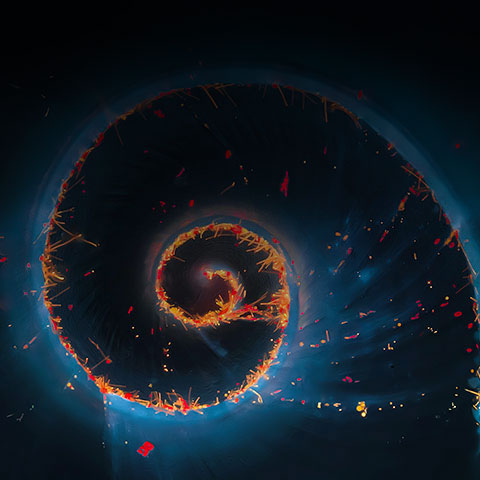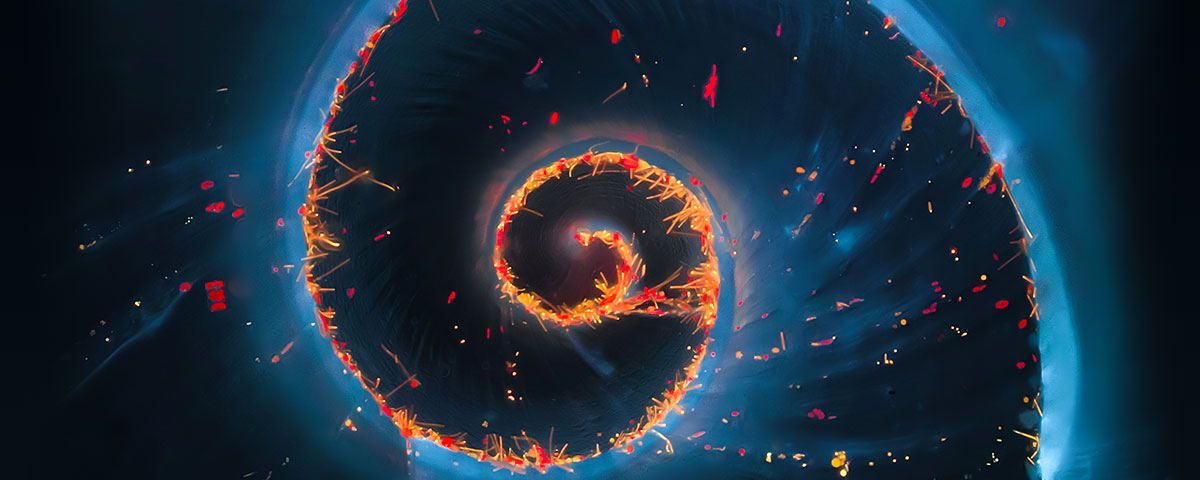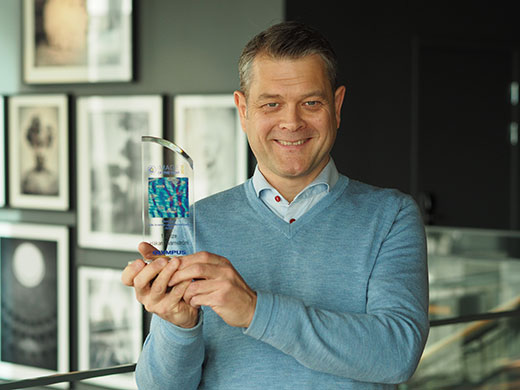| Håkan Kvarnström is the winner of the Olympus Image of the Year award The image displays a faint blue glow from the shell combined with fine |
|---|
Can you tell us the story behindthe picture?I was visiting a local fish farm in Stockholm and asked for a water sample. Usually these contain a lot of stuff I can look at under the microscope. I took a bag of water and brought it home, but I couldn't find anything interesting. However, when I poured all the water out, I found a small snail in the bottom of the bottle and I thought: maybe I'll have a look at that one. How did you create the image?When I put the snail under the microscope, I tried various techniques such as visible light and polarized light. When I put it under ultraviolet light using a fluorescence microscope, I discovered that it was autofluorescing in beautiful colors, so I took a few pictures of that. The snail was about 2 mm in size, which is quite small. I used the Olympus BX51 fluorescence microscope with a 10x objective and a Canon 6D camera. All the color The red you can see in the image is from algae. By looking at the shapes of some of the algae you might be able to recognize certain species. Autofluorescence from cyanobacteria is usually orange, so it’s likely that the snail has cyanobacteria growing on its surface. Why did you choose this picture as your entry for the award?One reason I chose this image is because of its spiral shape; I’ve always found the spiral patterns of nature fascinating. It’s a good example of the golden ratio, which appears everywhere in nature – from stars and galaxies down to the smallest of creatures. Because of this it’s sometimes difficult to know whether you are looking at a stellar phenomenon or at a microscopic structure. Where did you learn to use a microscope?I don't work with microscopes in my day job as I have a computer engineering background, but I’ve always been interested in sciences – biology, physics and mathematics. I'm always building stuff – electronics, computers and so on. I bought my first microscope when I was a teenager. To me, microscopes were a great technical toy to explore things and see things that I hadn’t seen before. My first microscope was simple, but I still found it very interesting to study hairs and insects, such as flies and ants. Why did you decide to use microscopes as tools for art?Photomicrographs serve many different purposes. In research, they are often used to highlight certain features of a specimen, for example, to prove or disprove research findings and theorems or in clinical work to diagnose a disease. The beauty of the image is secondary, and no attempts are made to enhance its visual appearance. Instead, I want to use these instruments only to make the best quality pictures – to get the maximum out of the technology to make images look as good as possible. A couple of years ago, I bought a new microscope but I soon realized that it couldn't do what I wanted, so I bought a more advanced one. Now I have a BX51, which is a pretty neat device. It has allowed me to really use microscopes to create beautiful art. In the last few years I have been expanding my home lab with new equipment and with all the capabilities of the BX51 – differential interference contrast, polarized, phase contrast, fluorescence – I now have a range of techniques I can play with to create different visual effects. What do you find most fascinating about microscopy?I’ve always been driven by the ability to look beyond what you can see with your eyes. The same goes for astronomy, I’m fascinated by looking at distant stars and distant galaxies that are invisible to the naked eye. I never get tired of looking drop after drop at a water sample, and trying to find something new. Almost every time, I find something I have never seen before. The amazing thing is, it’s so close to you. People are traveling around the world to get fantastic shots of Antarctica or Mount Everest, but you can also create fabulous pictures by simply looking at things that are close to you. Could you tell us what you’re working on next?I have several exciting projects in the pipeline. One that I am currently working on is my “duplo illuminata” series of images. It is inspired by photographer Stephen Wilkes’ “Day to Night” images where both night and day are captured in a single image. I decided to capture microscopic beauty using dual illumination and combine them into a single image. Some images in this series are made of up to 100 images stacked, stitched and then combined in photoshop to achieve a blended image combining the two illumination techniques. The challenge with this technique is to work fast enough behind the camera because any movement of the subjects will ruin the final image.v |
对不起,此内容在您的国家不适用。
对不起,此内容在您的国家不适用。


